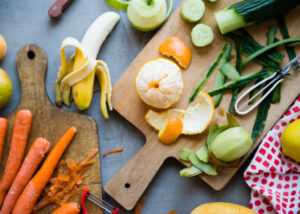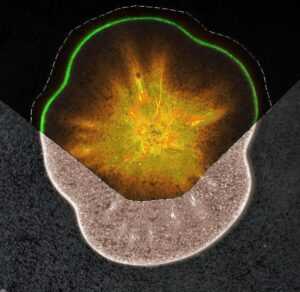In my darkest night, when the moon was covered and I roamed through wreckage, a nimbus-clouded voice directed me: “Live in the layers, not on the litter.” Though I lack the art to decipher it, no doubt the next chapter in my book of transformations is already written. I am not done with my changes. Stanley Kunitz, The Layers
In summertime we peel off our layers, remaining in the basic lightest. Winter invites us to wrap up, cover ourselves, and contemplate life, while winter vegetables evoke an important discourse regarding layers and old habits.
Like peeling vegetables, for instance… The skin of fruits and vegetables is in fact living and breathing tissue. The English term “skin” is an apt name, as one of its functions is holding together the softer tissue in one piece, like Seran wrap does. Just like human skin. Think about a soft tomato, for example, or a ripe apricot – they definitely need to be held intact. The skin also serves as protection from pests, sunrays, bruising and rotting. Especially before the fruit or vegetable ripens.
Sometimes, at that stage, the skin is hard and not very tasty (most of the time, just like the fruit itself), but it softens as the fruit ripens and its seeds are ready for dispersion. But sometimes the process is the other way around: at the unripe stage it is soft (like the skin of the cucumber or zucchini eaten at their unripe stage). Once the fruit reaches maturity, the skin hardens in order to protect the seeds from unnecessary rotting (think of their cousins the pumpkin or watermelon’s rind which we eat at a very ripe stage).
In Hebrew, the word for skin – קליפה – derives from the act of removal, as if meant to be separated and tossed aside. Not fair. We peel the skin off so many fruits and vegetables out of sheer habit, and that’s a shame. The skin stores many excellent components that are critical to the absorption of the valuable nutrients of the entire fruit of vegetable. This week, I challenge you to bundle up in your winter layers and shed some stubborn old conceptions to begin thinking differently about peeling vegetables and fruit.

So what’s in the skin? One of the important characteristics of fruits and vegetables is the dietary fibers they contain. These fibers divide into soluble and insoluble types. Fruit itself contains only soluble fiber, while its skin contains both types. How are they beneficial? Soluble fiber aids in lowering bad cholesterol (LDL) and blood sugar, while insoluble fiber absorbs liquid and then expands, improving digestion, alleviating constipation and hemorrhoids, cleansing the stomach and increasing the feeling of satiation over time. Such a pity to peel them away…
Skin also contains a good quantity of vitamins and minerals which we lose when we peel it off. Peeled fruit only contains a fraction of its nutritive potential. Sometimes the skin is more colorful or darker than the inside of the fruit, which usually means that it is richer in antioxidant phytochemicals that fight the free radicals, thus aiding the prevention of cell damage and its resulting damage. At times, the skin contains antioxidants which do not exist in the fruit itself.
Take the tomato, for example. Research conducted at the Weizmann Institute has found that antioxidants belonging to the lignin class exist in the skin but not in the actual flesh.

A slice of ripe tomato: the orange is the distribution of sucrose in the flesh, while the green is one of the antioxidants created in the skin. The components were mapped in the fruit cell by use of Mass Spectrometry Imaging (MSI). The photo is from “a journey in the scientific magic” published by the Weitzman Institute of Science.
Here are some additionalexamples:
Carrot – The peeling contains a sizable quantity of nutritional components ,Vitamin A, beta-carotene, calcium and dietary fibers.
Potato – The peel is very important, as the flesh contains primarily starch which transforms to sugar upon consumption. The insoluble fibers within the skin help to regulate sugar absorption. In addition, the peel is rich in folic acid, iron, Vitamin B and potassium. Potato peels contains polyphenol antioxidants while red peels contains antosianin antioxidants as well.
Cucumber – The peeling contains the highest quantity of Vitamin K within the entire vegetable (five times more than a peeled cucumber), as well as vitamins B and C. Cucumber peeling contains cholesterol-like molecules that aid in reducing the level of cholesterol in your blood, while the flesh only contains a very slight amount of phytosterols. To top it off, the peel is rich in Omega 6 as well.
Sweet Potato – A very interesting case of flesh and skin that contain different substances: the bulb is rich in vitamins A and B, while the peeling contains large, critical amounts of calcium, potassium, Vitamin A and dietary fibers.
Beets – Like the sweet potato, the beet, too, is a root with an abundance of minerals and vitamins inside: magnesium, potassium, selenium, calcium and folic acid. The peeling is rich in Vitamin A and nutritional fibers.
I chose only to discuss vegetables which do not actually require peeling. In our family we don’t remove the skin, less out of health concerns but more from laziness. We eat the peel along with the fresh or baked vegetable without giving it much of a thought. Sometimes a more vigorous scrubbing is necessary to remove mud from the cracks, but after researching the praises of the peeling, I gave myself a little pat on the back for my resolute laziness…. In that same (unpeeled) boat, you may add the Jerusalem artichoke which really does not require peeling – a hearty rubbing will suffice, parsley root and of course, the various radishes and turnips.
While I’m at it, why not tell you about a couple of fruits that are better consumed along with their skin. Far more challenging, but definitely worth considering:
Banana – Its peel is rich in lutein antioxidant, vitamins A and B, magnesium, potassium, tryptophan (to give your mood a boost) and dietary fibers (which will make you feel full). Not bad, eh? But how strange is it to think about eating banana peelings? You’d be surprised, just like I was, to find out it can even be tasty. Here are some ways to eat it
Should you choose not to eat the banana peel, it has many other uses, like soothing bruises, skin irritations and sores (acne, bites, rashes, calluses, you name it…). Place on the injured area as if you were bandaging it or rub lightly.
Citrus Fruits –The white flesh situated between the skin and fruit contains anti-inflammatory Bioflavonoids which fortify body cells and promote Vitamin C absorption in the bloodstream. The peel contains an abundance of Vitamin C, polyphenol and halimunan that is anti-inflammatory and can aid asthma sufferers. There are those (my Significant Other, for example) who eat the skin as is while peeling it off, but for the rest of the world there are many other ways to combine citrus zest in our nutrition: in cooked dishes, spreads or sauces, or old fashioned candied orange peel.
And if you’ve gone ahead and prepared a few jars of candy and still have leftover citrus peels, they are great in other ways besides in your food. For example, using the lemon as a powerful cleaning agent.

Of course, the question of to peel or not to peel is a personal decision. If the peel disrupts your eating and you can’t get used to eating the sweet potato along with its jacket – by all means, peel away and eat in good health. Sometimes the skin can be a burden on our digestive system. If you feel it causes too many insoluble fibers that complicate digestion, pare of the skin and enjoy it peeled. Keep an open mind: explore the possibilities and decide what’s best for you.
This week we happily welcome back Majdi, who has been recuperating from surgery. Great to have you back!
Wishing you a wintery snuggle among your various layers with or without the peeling, and a comforting wintery week,
Alon, Bat Ami, Dror, Yochai, Orin and the entire Chubeza team.
_________________________________
WHAT’S IN THIS WEEK’S BOXES?
Monday: Fennel/cabbage, lettuce, kohlrabi/beets/turnips, cucumbers/bell peppers, tomatoes, carrots, cauliflower, spinach/totsoi/kale, Jerusalem artichokes/broccoli, Swiss chard. Small boxes only: potatoes/ sweet potatoes.
Large box, in addition: Celery/celeriac, coriander/arugua, radishes/baby radishes/daikon, leeks.
FRUIT BOXES: Avocado, oranges, apples, bananas.
Wednesday: Fennel/kohlrabi/beets, lettuce, cucumbers/bell peppers, tomatoes, carrots, cauliflower, spinach/totsoi/red mizuna, kale/Swiss chard, Jerusalem artichokes/broccoli/snow peas or garden peas, potatoes/sweet potatoes, celery/celeriac/leeks.
Large box, in addition: Red or green cabbage, radishes/baby radishes/daikon, coriander/parsley/arugula.
FRUIT BOXES: Avocado, oranges, apples, bananas.
